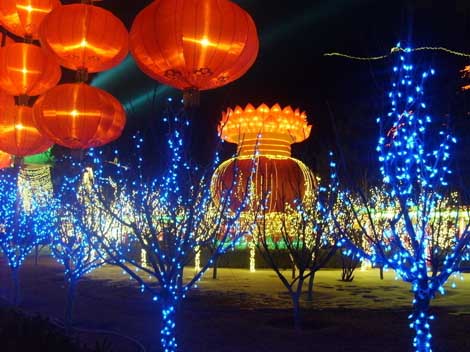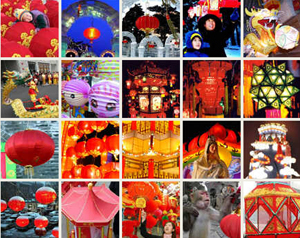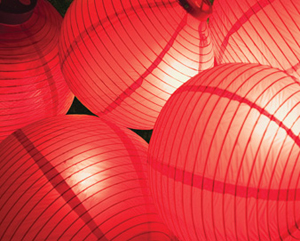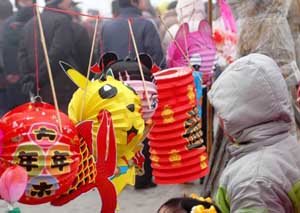
Lanterns (deng in Chinese) are a special handicraft of Chinese tradition. Fancy lanterns are widely used as decorations in the country during festivals and holidays, on weddings and other celebrations.

On the whole, they consist of a frame made of metal wire or bamboo strips covered with painted paper or a thin gauze. There is also a kind of a portable redwood frame that can be taken apart and folded up when not in use, which makes a great souvenir.
Many traditional lanterns are generally very fancy, like palace lanterns, lanterns with revolving figures, gauze lanterns, wall lanterns and glass silk lanterns. The lanterns on the Tian'anmen Tower, for example, are unusually large, red gauze lanterns. In olden times lanterns were commonly called qi si feng ("enraging the wind") because they were coated with fish glue, which made them windproof while letting the candlelight through. Today, of course, electric lights have long replaced candles.
An outstanding example is a lantern with revolving figures known as zou ma, which looks like a pretty paper pavilion with upturned eaves and corners. It is ringed with a number of colored figures of men and animals, or a panoramic landscape of mountains, rivers and flowers -- either painted or cut out of paper, which revolves like a merry-go-round.
This kind of "roundabout" lantern may be traced back to the Tang and Song dynasties about 1,000 years ago. The figures or pictures are erected along the circumference of a wire frame fastened to the center of a vertical shaft pasted with paper vanes. Propelled by hot air from a lit candle, the vanes turn the shaft, which turn the frame with the figures. Today, this kind of lantern has become more elaborate and beautiful, although the basic structure remains the same. It shows that the Chinese had already grasped the principle of transforming hot air currents into mechanical energy in ancient times.
The Lantern Festival

The Lantern Festival falls on the 15th day of the first lunar month, usually in February or March according to the Gregorian calendar. It marks the end of the Spring Festival (the Chinese New Year). As early as the Western Han Dynasty (206 BC-AD 25), it had become a festival with great significance. On that day, lanterns of various shapes and sizes are hung in the streets, attracting countless visitors. Excited children carry bought or handmade lanterns as they stroll down the streets.
This day's important activity is watching lanterns. Throughout the Han Dynasty (206 BC-AD 220), Buddhism flourished in China. One emperor heard that Buddhist monks would watch sarira, or remains from the cremation of Buddha's body, and light lanterns to worship Buddha on the 15th day of the 1st lunar month, so he ordered to light lanterns in the imperial palace and temples to show respect to Buddha on this day. Later, the Buddhist rite developed into a grand festival among common people and its influence expanded from the Central Plains to the whole of China.
Till today, the lantern festival is still held each year around the country. Lanterns of various shapes and sizes are hung in the streets, attracting countless visitors. Children will hold self-made or bought lanterns to stroll with on the streets, extremely excited.
People will eat yuanxiao, or rice dumplings, on this day, so it is also called the "Yuanxiao Festival." Yuanxiao also has another name, tangyuan. It is small dumpling balls made of glutinous rice flour with rose petals, sesame, bean paste, jujube paste, walnut meat, dried fruit, sugar and edible oil as filling. Tangyuan can be boiled, fried or steamed. It tastes sweet and delicious. What's more, tangyuan in Chinese has a similar pronunciation with "tuanyuan", meaning reunion. So people eat them to denote union, harmony and happiness for the family.
In the daytime of the Festival, performances such as a dragon lantern dance, a lion dance, a land boat dance, a yangge dance, walking on stilts and beating drums while dancing will be staged. On the night, except for magnificent lanterns, fireworks form a beautiful scene. Most families spare some fireworks from the Spring Festival and let them off in the Lantern Festival. Some local governments will even organize a fireworks party. On the night when the first full moon enters the New Year, people become really intoxicated by the imposing fireworks and bright moon in the sky.
Guessing lantern riddles

Guessing lantern riddles is a very popular activity during festivals or other special occasions in China. Lantern owners write riddles on a piece of paper and post them on the lanterns. If visitors think they know the answers to the riddles, they can pull the paper out of the lanterns and go to the owners to check them. If they are right, they receive a little gift. The activity emerged when people enjoyed lanterns during the Song Dynasty (960-1279). Since riddle guessing is interesting and full of wisdom, it has become popular among all members of society.





